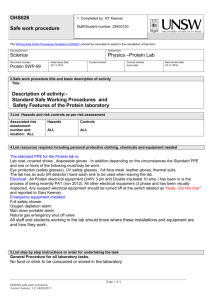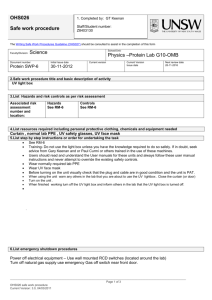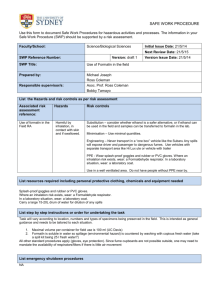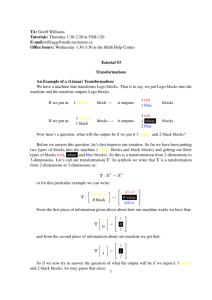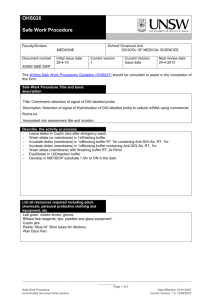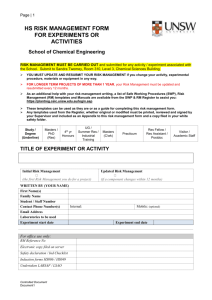Cash flow management for SWP
advertisement
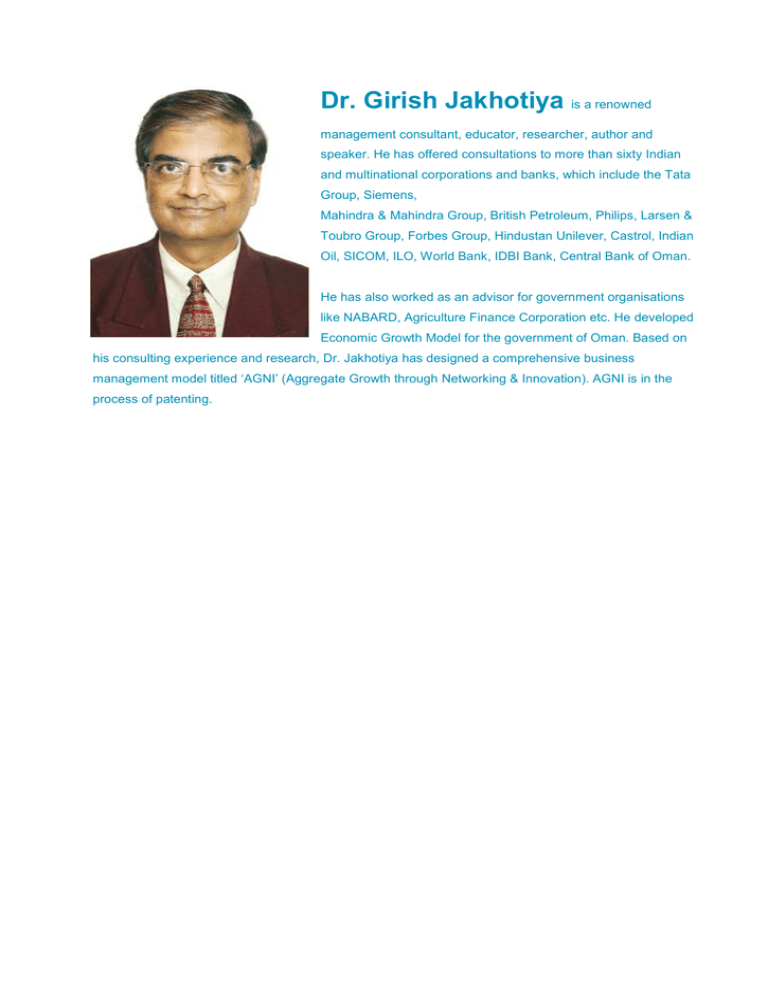
Dr. Girish Jakhotiya is a renowned management consultant, educator, researcher, author and speaker. He has offered consultations to more than sixty Indian and multinational corporations and banks, which include the Tata Group, Siemens, Mahindra & Mahindra Group, British Petroleum, Philips, Larsen & Toubro Group, Forbes Group, Hindustan Unilever, Castrol, Indian Oil, SICOM, ILO, World Bank, IDBI Bank, Central Bank of Oman. He has also worked as an advisor for government organisations like NABARD, Agriculture Finance Corporation etc. He developed Economic Growth Model for the government of Oman. Based on his consulting experience and research, Dr. Jakhotiya has designed a comprehensive business management model titled ‘AGNI’ (Aggregate Growth through Networking & Innovation). AGNI is in the process of patenting. Strategic wage planning Strategic or long term wage planning (SWP) is the ‘joint task’ of the CEO, CFO and CHRO (Chief human resource officer) supported by an executive committee comprising of business and other functional heads as its members. SWP is basically a ‘vision-based’ attempt of framing-up a long term wage approach and wage plan considering the complex externalities and internalities an organisation would face. SWP is mainly based on the various permutations and combinations of three major factors viz. positioning of a business enterprise in its life cycle, changes in its business model arising out of various compulsions, growth opportunities and cyclical or environmental changes as uncontrollable externalities. In other words, an SWP is a three dimensional process with intrinsic risks and uncertainties. Let us first look at the first major factor that mostly influences the SWP i.e. positioning in the life cycle. Normally, a business enterprise grows and transforms through the following life cycle stages. Perpetuity (and related challenges) Position Market leadership (Trend setter) Consolidation II (Mostly through an inorganic process) Consolidation I (Mostly through an organic process) Take off Promotion 0 Inception Life cycle of a business enterprise Time During its life cycle, an enterprise grows on all three fronts – volume, variety and value. These vehicles are applicable to strategic human resource planning. Especially, the behaviour of these variables being inter-dependent, the composite impact at every stage of the life cycle could be drastically different. The other dimension of this complexity is the problem in defining the time-scale on which these stages of growth would actually materialise. Exact projection of time gap between two stages facilitates good assessment of the impact of cyclical changes. In other words, SWP depends on the stages of growth in the life cycle, but seriously and simultaneously impacted by the external factors e.g. socio-economic change, global environment etc. The impact of volume, variety and value on the SWP may be broadly viewed as follows considering the life cycle stages. Sr. Life cycle Impact on the SWP of volume, variety and value no. stage of an Volume Variety Value enterprise (i.e. quantum of (i.e. variety of (i.e. cost variations output and human products, markets along with various resources and employee value propositions competencies) presented to the customers) 1 Inception and Select human resources Entrepreneurial More of project related promotion with systemic support competency of the cost promotional team 2 3 Take off Reasonable product Limited variety and Managed cost, focused output, growing number limited exposure value proposition and of human resources with well defined cautionary approach to deliverables from expansion human resources Consolidation – Considerable size of Good variety of Volume-driven cost, I product output, good products and markets, ambitious value influx of systemic bigger variety of propositions and employees and decision employee corresponding making executives competencies competency flexibility required by all employees and employee cost impacts value 4 Consolidation – High product volumes, Complex variety of A large mix of different II geographical spread products, markets and product – process – and proportionately employees, different people costs, complex large number of human cultural and combinations of value resources competency and cost vis-a-vis value backgrounds, different and employability wage structures with regional differences 5 Market Volume sustenance, Managing the Product, process and leadership employee competence equilibrium of the employee-wise profit and compensation variety mix centres emerge, sustainability performance and cost monitoring Table: Impact of volume, variety and value on SWP As mentioned earlier, the externalities of cyclical changes, socio-economic variations, emergence of new technologies and competencies, global movement of labour add to the complexity of SWP. The trio of the CEO, CFO and CHRO have to constantly monitor their radar reflecting the externalities. As a business enterprise grows in its life cycle, its capacity of managing the externalities too improves; provided it maintains reasonable structural flexibility. A large organisation with its systems and capacities (or facilities) develops ‘bureaucratic rigidity’. Therefore, strategic changes in human resource plan may become difficult or very expensive. A diagrammatic explanation of this reality may be presented as follows Capacity to face the impact of externalities Structural, cultural and systemic rigidity 0 Life cycle of an enterprise 0 Strategic changes in human resource plan SWP should consider the following major externalities 1. Change in socio-economic environment. 2. Impact of global networks (mechanisms like the WTO) 3. Basic performance of an economy (i.e. country), and in its sectors viz. manufacturing, agriculture and service. 4. Impact of natural uncertainties on the sustainability of a business enterprise and the economy of its country. 5. Cyclical changes in a particular industry in which an enterprise exists. 6. Change in the fiscal policies of the government. One can now imagine the combination of two factors: i.e. position in the life cycle and an externality. The impact could be more complex if two or more externalities work together. Very often, the top trio faces a dilemma of defining ‘known risk’ vs. an ‘unknown uncertainty’ while treating the results of these combinations. SWP becomes more complex if the uncertainties are not converted into risks. Therefore, macro level mapping of the externalities becomes a regular strategic exercise A business enterprise manages the uncertainties of the above combinations through two alternate models. These two models are geographical diversification and business model variations. A multinational corporation naturally exploits its status of being internationally located. With globalisation of business and technological advancement, such diversification has become very easy. A corporation would have its sourcing facilities in different countries to gain from ‘natural hedge of externalities’. The risk of externalities is minimised by engaging geographically diversified human resources. The second model, ‘Business model variations’ is comparatively difficult to execute. It basically requires ‘value chain alterations’ for the same business in different regions. Business model or value chain alterations are used keeping in mind the expected impact of externalities on SWP. For example, in a country or region where the ‘son of soil issue’ is complex, a business enterprise would prefer to outsource most of its ‘non-critical processes’ through ancillaries or vendors. In another region, where labour mobility is allowed, the same enterprise may employ different types of labourers for varied value-adding processes and exploit such diversity for the multiple advantages of competence variation, wage variation and cultural variation. In a country where ‘human resource competence’ is available at an entrepreneurial level of employment, a multinational corporation would prefer to have two distinct SWPs – one for the local human resources and another for the expatriate executives (who are in small number). So far we discussed two dimensions or determinants of the SWP. The third is the ‘business model’. It may vary from one stage to another stage in the life cycle of an enterprise. For example, an enterprise enjoying the status of ‘market leader’ may expand its business through franchises. It is a matter of brand extension, technology transfer and process supervision by the principal company. Naturally most of the SWP becomes a primary responsibility of a franchise. The principal company would monitor the cost and competence of the franchise’s human resources. A business model is essentially a combination of ‘value chain structure’ and ‘sharing of reward and responsibility among the stakeholders’. (The major stakeholders are shareholders or owners, employees, vendors and ancillaries, distributors and agents, and other business associates. The ‘value chain structure’ evolves with the maturity of equilibrium among the operational, financial and strategic factors affecting the performance of a business enterprise. In other words, the most profitable combination of these three factors is tried out every time and corresponding change in the value chain is attempted. Of course, a right time and right quantum change is always a difficult decision. Let us compare two business models with their corresponding value chains. Business model A: Sales and distribution directly done by company’s employees Suppliers Purchase Production Sales & distribution HR competence and cost planning is high Business model B: Sales and distribution is done by the stockists and agents. Supervision is done by company’s marketing team which is slim. Company’s team Suppliers Purchase Production Stockists and agents Internal HR cost is minimal. Commission and credit cost is more Selecting business Model A or B would depend on the types of market, product speciality and maturity stage of a business enterprise in its life cycle. Business model A primarily depends on ‘internal value creators’ i.e. employees. Business model B mostly depends on ‘external value creators’. Both models have their own suitability and limitations. In summary, we saw that there are five major stages in the life cycle of an enterprise. It has to face six important externalities and it has two choices of business models based on the role of internal and external value creators. Statistically, we may conclude that there could be ‘5 x 6 x 2’ i.e. 60 permutations and combinations of these three factors influencing the SWP. Cash flow management for SWP Long term cash flow management is very critical for the success of any SWP. Along with other major costs like material and operating overheads, the employee cost puts lot of pressure on a company’s cash flows. Eventually, its accounting treatment also influences the income statement seriously. At various stages of the life cycle, the cash flows would vary depending on the peculiarities of business status. These cash flows could be positively or negatively influenced by the externalities and choice of business model. The CHRO should closely work with the CFO while projecting these cash flows. Although short term liquidity and profitability is affected by these cash flows, a long term view of growth and sustainability cannot be neglected. Let us look at the behaviour of cash flows driven by the compulsions of the life cycle stages and their impact on a company’s bottom line. Table: Life cycle stages and cash flows on account of important components of the wage cost Life cycle Components of the wage cost stage Selection and Training and Retention New Aspiration Separation deployment development cost competence and/ or cost cost cost building cost promotion cost Inception and promotion Average Low Low Low Low Very low Take off High High High Low Low Low Consolidation I Very high Very high Average Average Average Low Consolidation II Proportionately high Average High High High Average Market leadership Low Average High Very high Very high Low Table: Life cycle stages, components of the wage cost, accounting treatment and impact on the income statement (IS) Life cycle Components of the wage cost and accounting treatment with corresponding impact on stage income statement (IS) Selection & Training & Retention New Aspiration Separation deployment cost development cost competence or / and cost building promotion cost cost cost Inception and promotion To be written off in 3 years, low impact on IS To be written off in 3 years, low impact on IS Annual cost, low impact on IS Annual cost, low impact on IS Annual cost, low impact on IS Annual cost, no impact on IS Take off To be written off in 3 years, reasonable impact on IS To be written off in 5 years, reasonable impact on IS To be written off in 5 years, considerable impact on IS Annual cost, low impact on IS Annual cost, low impact on IS Annual cost, low impact on IS Consolidation I To be written off in 3 years, reasonable impact on IS To be written off in 5 years, reasonable impact on IS Annual cost, low impact on IS Annual cost, low impact on IS Annual cost, low impact on IS Annual cost, very low impact on IS Consolidation II To be written off in 3 years, considerable impact on IS Annual cost, low impact on IS To be written off in 2-3 years, considerable impact on IS To be written off in 2-3 years, considerable impact on IS To be written off in 2-3 years, considerable impact on IS Annual cost, low impact on IS Market leadership Annual cost, very low impact on IS Annual cost, low impact on IS Annual cost, reasonable impact on IS To be written off in 2-3 years, considerable impact on IS Annual cost, considerable impact on IS Annual cost, low impact on IS The CEO, CFO and the CHRO will have to always establish a balance between the ‘recurring wage cost’ incurred for short term tangible results and the ‘capital wage cost’ to be treated as a long term investment in human resources as company’s distinguishing assets. Challenges in making SWP a fool-proof exercise There are few major challenges companies normally face when bringing perfection to SWP. Different companies face them differently based on their priorities, conveniences of the promoters, market conditions etc. An organisation believing in long term, sustainable and all-round growth, views SWP as an important tool for retaining and enhancing the competitiveness of its human resources. The challenges may be narrated as follows. 1. Striking a balance between ‘wages for yearly measurable results’ and ‘wages for long term goals’ has always been a challenge. Short term profitability and long term sustainability should be viewed as complementary and not contradictory. This could be achieved through a pragmatic performance management system. 2. Choosing between the extremes of capitalist structure and socialist structure of wages is also a A business model difficult act of balancing between entrepreneurial reward and organisational equity. Lately the is essentially a capitalist structure has proved to be a ‘road to greed and related manipulations in measuring results’. Socialist structure stagnates a business enterprise as it kills entrepreneurship. Due flexibility and legitimacy in the compensation combination of ‘value chain structure’ and system facilitates an act of equilibrium between entrepreneurial aspiration and systemic control. ‘sharing of reward 3. Promoters who are working as managers in the business, always face a dilemma between ‘profit- and responsibility based incentives’ and ‘dividend pay-out’. The distinction between entrepreneurial risk and managerial risk is a difficult exercise to do. Promoters have to achieve a fair equivalence among the stakeholders’. between corporate governance and enterprise governance by strategically managing their rewards. This is very essential for long term sustenance of the morale of a company’s human resources. 4. Value-driving employees always expect a differential treatment. Rewarding them adequately without disturbing the fabric of cultural equity is always a challenge. In addition to ‘differential wages’, they could be rewarded and recognised through the methods of extra empowerment, opportunities of greater competence building, long term plan of ownership sharing etc. 5. Considerable level of confusion exists about rewarding employees from prime operations and subordinate operations. This becomes complex when rewarding ‘star employees’ from the subordinate operations. Another added complexity is when a subordinate function becomes critical as a result of an externality or change in the business model. 6. ‘Regional cost differences’ should be considered when defining regional wage parity. This could be a complex exercise for a multinational company facing globalisation of human resource movement. Regional wage disparity may be a result of selecting a business model based on regional peculiarities. A region’s wage cost competitiveness may not be sustainable in long-run. Visualising such possible future dilemma is a challenge for a CHRO. Such visualisation impacts the overall strategic plan of a business enterprise. 7. The doctrine ‘perform and then get paid’ may not always be an attractive proposition for the employees. Even the promoters get confused between selecting a ‘short term, volume-based reward system’ and a ‘long term, sustainable reward system based on sustainable paying capacity of the organisation’. Higher incentives paid during boom time are very difficult to be retained during bad times. Very often, ‘systemic’ employees are not ready to accept this reality. Hence, raising the bar of incentivisation becomes a strategic decision. 8. Inorganic growth through acquisitions causes the complex dilemma of equating productivity and wage structures of different organisations merging together. An aspirational gap becomes a further criticality caused by different cultural backgrounds. Transparency, legitimacy, reasonability and sustainability are the four ways to tackle the ‘wage dilemma’ imposed by the acquisitions. 9. A trade-off between the capital investment in technological advancement and a similar investment in employee capability advancement is always a strategic exercise. This trade-off becomes a difficult task when the externalities impose serious uncertainty about a company’s business model and threaten its competitive advantage. 10. A common challenge that all organisations face is achieving a sustainable equilibrium between ‘wages for yesterday’s contribution, wages for today’s performance and wages for post-retirement days’. Impact of generation gap, drastically changing concepts of employability and related uncertainty, globalised standards of compensation and uncertainty of the business model are the most critical factors impacting this equilibrium. To conclude, strategic wage planning is a joint effort of the CEO, CHRO and CFO. They need to understand and appreciate the combined impact of life cycle positioning of their business enterprise, critical externalities and business model alterations. To Make the SWP fool-proof, this trio should visualise the possible impact and formulate pragmatic strategies to minimise the damage done by such impact. The ultimate success of SWP may be measured by its contribution to a company’s long term sustainable growth.
